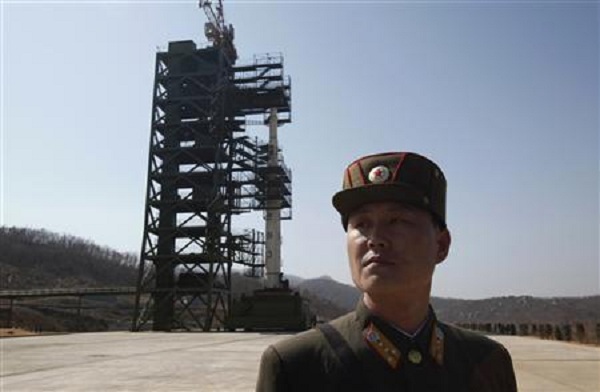North Korea Possibly Preparing for Missile Launch, Drives Wedge Between China and US
| Carlos Castillo | | Jan 30, 2016 06:40 AM EST |
(Photo : Reuters) A military sentry (above) guards a missile site in this photo taken in North Korea. Camouflage screens on North Korea's Sohae (also called "Tongchang-ri") rocket launching site impede a precise assessment of Pyongyang's progress toward a test launch, according to one expert. Nonetheless, the country is thought to be preparing for a long-range missile launch.
North Korea may be preparing a missile test in defiance of international sanctions and a new United Nations Security Council (UNSC) resoultion condemning Pyongyang for detonating what it claims was a small hydrogen bomb earlier this month, experts have said.
New information based on satellite imagery of North Korea's Sohae Satellite Launching Station suggests Pyongyang is preparing to launch a long-range ballistic missile, with camouflage panels erected in key parts of the facility apparently meant to obstruct satellite surveillance.
Like Us on Facebook
"We predict that North Korea's next significant military provocation will be carried out in a surprising manner," said Kim Min-seok, spokesman for the South Korean defense ministry, at a press conference on Thursday in Seoul.
The new information comes on the heels of a new UNSC resolution condemning North Korea for its latest underground nuclear test.
Some observers have raised concerns that a rocket launch coming so soon after a nuclear test could mean that North Korea plans to load nuclear warheads onto its long-range ballistic missiles. Experts have said this would give Pyongyang the capability to launch a nuclear strike on Japan, South Korea and the US western seaboard.
China's Predicament
CBS News reports that many South Korean experts see the North's continued military provocations as a carefully calculated move, "with tangible objectives."
North Korea's testing of a long-range missile is likely to push Seoul toward the deployment the Terminal High Altitude Area Defense (THAAD) missile systems championed and manufactured by the US and vehemently opposed by China. The radar systems of the THAAD missile arrays extend well into Chinese borders, and their deployment could spark a diplomatic row between Beijing and Seoul.
Professor Kim Han-kwon of the Korea National Diplomatic Academy in Seoul believes the provocations are part of a North Korean strategy to isolate China -- its only remaining ally -- from the rest of the international community.
China is under increasing pressure to impose crippling sanctions against Pyongyang, but Beijing has so far avoided concrete steps toward punishing its troublesome ally for fear that a political collapse in the North would spill chaos into Chinese territory. The UNSC impasse has already put into stark focus a division between China and the US and its allies in the council.
"North Korea appears to be intent on driving a wedge between the US and China," Kim told South Korea's YTN news network. "From North Korea's perspective, a schism between China and the US is the ideal situation."
He said a new long-range missile test would wheedle the US and its allies to push for stronger sanctions against Pyongyang, which would in turn force China to defend its wayward neighbor. "Because of the strategic interests at stake, China will be forced to further embrace North Korea," Kim added.
Suspicious Movements
In a report published by the 38 North website, scientist Jack Liu says the camouflage screens on the North Korean missile site impede a precise assessment of Pyongyang's progress toward a test launch. Some analysts have speculated that the North may also be using an underground railway to transport parts of the rocket to the facility, making movement impossible to track from space.
"If North Korea follows previous pre-launch preparation activities, we would expect to see in the coming days increased site-wide activity," Liu said, predicting the appearance of tracking equipment and more movement around the launch area's fuel bunkers and launch pad.
Previous analysis on 38 North conducted by academics from America's Johns Hopkins University accurately identified preparations for Pyongyang's last missile launch in December 2012, and its nuclear test blast on January 6.
Both Tokyo and Seoul have put their defense forces on alert, and several South Korean media outlets have reported that Japan is considering the deployment of missiles to shoot down North Korean rockets that enter Japanese airspace.
"We will take steps to respond, but I will refrain from revealing specific measures given the nature of the situation," said Japanese defense minister Gen Nakatani on Friday when asked about Japan's defensive preparations.
Tagschina north korea, North Korea nuclear test, UN security council violations
©2015 Chinatopix All rights reserved. Do not reproduce without permission
EDITOR'S PICKS
-

Did the Trump administration just announce plans for a trade war with ‘hostile’ China and Russia?
-

US Senate passes Taiwan travel bill slammed by China
-

As Yan Sihong’s family grieves, here are other Chinese students who went missing abroad. Some have never been found
-

Beijing blasts Western critics who ‘smear China’ with the term sharp power
-

China Envoy Seeks to Defuse Tensions With U.S. as a Trade War Brews
-

Singapore's Deputy PM Provides Bitcoin Vote of Confidence Amid China's Blanket Bans
-

China warns investors over risks in overseas virtual currency trading
-

Chinese government most trustworthy: survey
-

Kashima Antlers On Course For Back-To-Back Titles
MOST POPULAR
LATEST NEWS
Zhou Yongkang: China's Former Security Chief Sentenced to Life in Prison

China's former Chief of the Ministry of Public Security, Zhou Yongkang, has been given a life sentence after he was found guilty of abusing his office, bribery and deliberately ... Full Article
TRENDING STORY

China Pork Prices Expected to Stabilize As The Supplies Recover

Elephone P9000 Smartphone is now on Sale on Amazon India

There's a Big Chance Cliffhangers Won't Still Be Resolved When Grey's Anatomy Season 13 Returns

Supreme Court Ruled on Samsung vs Apple Dispute for Patent Infringement

Microsoft Surface Pro 5 Rumors and Release Date: What is the Latest?










